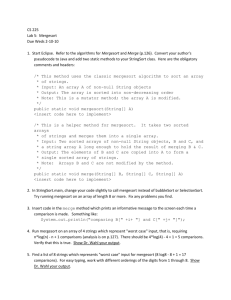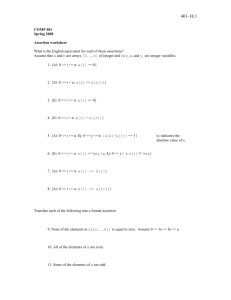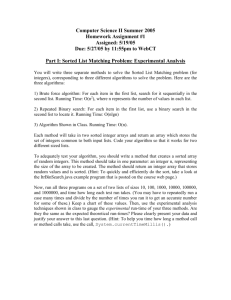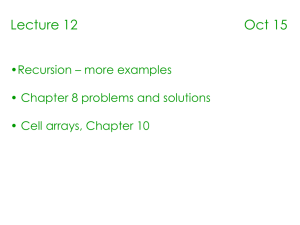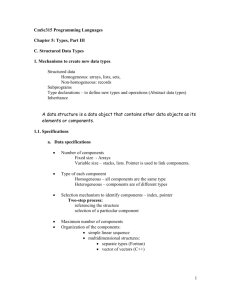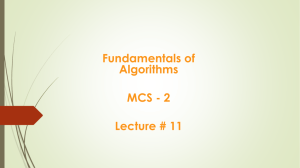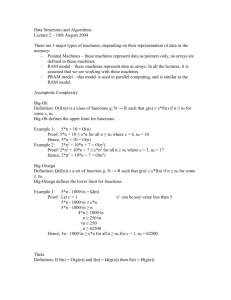Here are a few notes on mergesort. Merge Procedure Here is a
advertisement
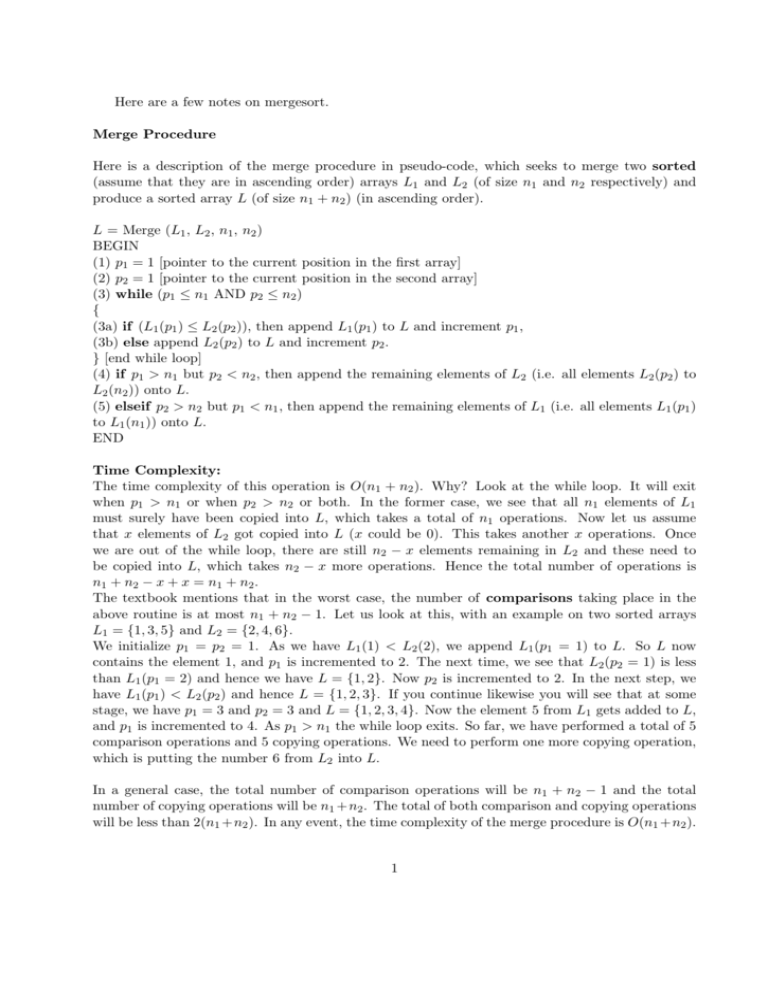
Here are a few notes on mergesort.
Merge Procedure
Here is a description of the merge procedure in pseudo-code, which seeks to merge two sorted
(assume that they are in ascending order) arrays L1 and L2 (of size n1 and n2 respectively) and
produce a sorted array L (of size n1 + n2 ) (in ascending order).
L = Merge (L1 , L2 , n1 , n2 )
BEGIN
(1) p1 = 1 [pointer to the current position in the first array]
(2) p2 = 1 [pointer to the current position in the second array]
(3) while (p1 ≤ n1 AND p2 ≤ n2 )
{
(3a) if (L1 (p1 ) ≤ L2 (p2 )), then append L1 (p1 ) to L and increment p1 ,
(3b) else append L2 (p2 ) to L and increment p2 .
} [end while loop]
(4) if p1 > n1 but p2 < n2 , then append the remaining elements of L2 (i.e. all elements L2 (p2 ) to
L2 (n2 )) onto L.
(5) elseif p2 > n2 but p1 < n1 , then append the remaining elements of L1 (i.e. all elements L1 (p1 )
to L1 (n1 )) onto L.
END
Time Complexity:
The time complexity of this operation is O(n1 + n2 ). Why? Look at the while loop. It will exit
when p1 > n1 or when p2 > n2 or both. In the former case, we see that all n1 elements of L1
must surely have been copied into L, which takes a total of n1 operations. Now let us assume
that x elements of L2 got copied into L (x could be 0). This takes another x operations. Once
we are out of the while loop, there are still n2 − x elements remaining in L2 and these need to
be copied into L, which takes n2 − x more operations. Hence the total number of operations is
n1 + n2 − x + x = n1 + n2 .
The textbook mentions that in the worst case, the number of comparisons taking place in the
above routine is at most n1 + n2 − 1. Let us look at this, with an example on two sorted arrays
L1 = {1, 3, 5} and L2 = {2, 4, 6}.
We initialize p1 = p2 = 1. As we have L1 (1) < L2 (2), we append L1 (p1 = 1) to L. So L now
contains the element 1, and p1 is incremented to 2. The next time, we see that L2 (p2 = 1) is less
than L1 (p1 = 2) and hence we have L = {1, 2}. Now p2 is incremented to 2. In the next step, we
have L1 (p1 ) < L2 (p2 ) and hence L = {1, 2, 3}. If you continue likewise you will see that at some
stage, we have p1 = 3 and p2 = 3 and L = {1, 2, 3, 4}. Now the element 5 from L1 gets added to L,
and p1 is incremented to 4. As p1 > n1 the while loop exits. So far, we have performed a total of 5
comparison operations and 5 copying operations. We need to perform one more copying operation,
which is putting the number 6 from L2 into L.
In a general case, the total number of comparison operations will be n1 + n2 − 1 and the total
number of copying operations will be n1 + n2 . The total of both comparison and copying operations
will be less than 2(n1 +n2 ). In any event, the time complexity of the merge procedure is O(n1 +n2 ).
1
Merge Sorting
Look at the pseudo-code for mergesort on page 318 of the book. It recursively divides the array in a peculiar way until you get just individual elements. The merge procedure is then applied
bottom-up. In class, I simplified this by asking you to directly look at individual elements and
merge them to produce sorted sub-arrays of size 2 each, then take adjacent sub-arrays of size 2 and
merge them to produce sorted sub-arrays of size 4, and so on, until you get one final sorted array.
In class, we derived the time complexity of the entire mergesort procedure to be O(n log n). Here
is a gist: There are some k steps, in each of which we spend O(n) time in the different merging
operations. What is the maximum value of k? Again: In the first step, we had n arrays each of
size 1 which were merged to give you n/2 arrays each of size 2, which again were merged in the
second step to give you n/4 arrays of size 4. This will go on for k steps. In the k th step, a total
of n/2k−1 arrays, each of size 2k−1 are merged to give the final array. Clearly this can go on only
until 2k = n, i.e. until k = log n. Hence the total number of steps is equal to log n, yielding an
overall time complexity of O(n log n).
I assumed, in this case, that the size of the original array was in the form n = 2m where m is
an integer. The natural question is what if n is not an integral power of two. There are several
things you can do. Here is one: Let us suppose that n wasn’t an integral power of 2, so that
2m < n < 2m+1 . Now let us add some x dummy elements to the array (a dummy element could
be something like a very large number) so that n + x = 2m+1 . In the very worst case, we need to
add x = 2m − 1 dummy elements and this will at most double the size of the original array. In
other words, we now would have n0 = 2m+1 elements instead of n elements (and note that n0 < 2n).
Now apply the mergesort procedure to this new array. The total time complexity is O(n0 log n0 ),
i.e. O(2n log 2n), which is no worse than O(n log n). There are many other tricks some of which
will be quicker by a constant factor, but they will not affect the time complexity. Therefore we lose
nothing by restricting ourselves to arrays whose size is an integral power of 2 (if at all, it simplifies
the analysis).
2



